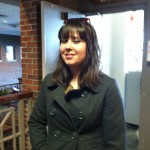Despite changes, HBC serves as a safe haven for minority students
By Spenser Hickey
Assistant Copy Editor
The House of Black Culture serves as a focal point for educating the Ohio Wesleyan community on Black history and issues, as well as a meeting place for the African-American community.
Named after Butler A. Jones, the University’s first African-American professor, the House of Black Culture was founded in 1970 by Pete Smith and Barbara McEachern Smith.
Smith and McEachern also started the Student Union on Black Awareness.
In 1970, there were only around 40 African-American students at Ohio Wesleyan, according to a Connect2OWU article on the Smiths.
HBC, known then as the Black House, was a “safe haven” for African-American students, said junior Lehlohonolo ‘Lucky’ Mosola, HBC’s Resident Adviser.
“Now, though, it’s used much more as a community meeting place for students in general, but specifically students in the African-American community,” Mosola said. “It’s certainly a focal point for the community now more than any kind of a protection.”
Terree Stevenson, Director of Multicultural Student Affairs, said she thought it has “the same [role] today as it was historically, and more so.”
She said it still serves as a safe haven for students to feel physically, emotionally, mentally, culturally and spiritually safe, as well as a programming space and historical reference for alumni who lived there.
“I think it’s a symbol of a long-standing opportunity for the university to create and support a place for students of color,” she said.
Mosola, currently in his second year at HBC, said he joined the House because his high school program provided little contact with other African-American students, something he wanted to make up for at OWU.
“After my freshman year, I got to know somebody who lived here, and I joined BMF (Black Men of the Future), which is a student organization I met a lot of people here through,” he said.
Freshman Jerrell James, who applied to live at HBC next year, said he sees it as “a common ground” where he can be himself.
Aaron Cameron, also a freshman, said he thinks it’s “a place where people can meet and converse and basically just have a good time, live life.”
Senior James Huddleston, HBC resident and co-president of BMF, said he sees the house as a place where he can let his guard down.
He credited living there with encouraging him to focus on academics.
Junior Shelby Alston said her sister, a graduate and former HBC resident at the time, introduced her to the house.
“I just instantly fell in love with this house,” she said. “It’s just this atmosphere is so welcoming and so open.”
She said many residents, past and present, are “big influences on this campus” as upperclassmen and African-Americans making “an impact and a difference.”
Junior Madeleine Leader said she’s excited to join HBC and live with people who “practice what they preach, and who live for what they’re passionate about.”
At the same time, she acknowledged that there is “a struggle” identifying with the African-American community as a white person, offering her Residential Life application to live at HBC as an example.
She said she’s been involved in activism for racial equality her whole life and is a member of SUBA and Vice President of Sisters United at Ohio Wesleyan.
“Being around people like this, you realize what you’re fighting for and why it’s so important to celebrate our differences and come together and keep fighting for them,” she said.
Leader said she identified with “being attacked for the person you are at your core” since she was ridiculed as a child for being a Jew.
She said there is “zero awareness” of how often students use racially-charged words.
“I’ve heard plenty of white students say the n-word to each other,” she said. “It’s just the obliviousness to what this community is about, especially on this campus, because they’re fighting for something, but the only thing they ever think about for BMF or the house is their parties. That’s offensive to me.”
Alston said being the House of Black Culture carries a certain stigma among the general community.
“I’ve heard people saying they’re afraid to come here, or will they get hurt if they come here [or] all we do is party,” she said.
“It hurts to see that this house has such a rich and unique legacy, and people only focus on the negative stuff or the stuff they see us for, like, ‘Oh, they throw awesome parties,’” she said.
“Well, what else have we done, besides parties, because we’ve done so much, and do you forget the events we’ve put on?”
Events they’ve held, she said, included a lecture by Terrence Roberts, one of the Little Rock Nine, a group of African-American high school students who initiated desegregation by attending a formerly all-white Arkansas school. Alston said Roberts “captivated the audience.”
While HBC was formed as a SLU, it made the transition to being a heritage theme house this year.
Mosola said the change came due to the SLU renewal process.
Each year, SLUs must apply for and earn renewal from the university or be shut down; however, Mosola said “the school said pretty much unequivocally that they weren’t going to shut the House of Black Culture down.”
This made it unfair for HBC, which wouldn’t be shut down, to be in the same category as houses that could be shut down. This distinction led to unnecessary work for HBC members.
Despite the change, Mosola said, practically it’s “very much similar,” but the house does less programs now, since not all members are required to plan individual events.
Weekly Public Safety Reports
Week of Feb. 5 to Feb. 11
Feb. 5, 8:05 a.m. – A Hayes Hall resident was transported to Grady Hospital on a welfare concern.
Feb. 6, 12:23 a.m. – Public Safety was dispatched to Corns on a trouble fire alarm.
Feb. 7, 3:16 p.m. – Public Safety was dispatched to the Science Center to meet with staff about a fire in a lab machine.
Feb. 7, 10:30 p.m. – Public Safety was dispatched to Austin Manor to meet an OWU student on a welfare concern following up on a previous incident.
Feb. 9, 2:00 a.m. – Public Safety was dispatched to Corns for a trouble alarm. After the building was declared all clear, and electrician was called to reset the system.
Feb. 9, 3:50 p.m. – An Aramark housekeeper called to document an injury from a trip and fall that occurred in Benes Room A. No first aid was required.
Feb. 9, 11:10 p.m. – Public Safety was dispatched to Smith Hall for alcohol discovered in the room by RA’s. No one was in the room and the owner of the alcohol could not be found. The alcohol was confiscated and destroyed.
Feb. 11, 12:05 a.m. – Public Safety was dispatched on a fire alarm in Hayes Hall.
Feb. 11, 12:20 a.m. – Public Safety was dispatched to the House of Thought on a trouble alarm. The smoke detector was activated without reason and an electrician was called.
Senior SLU members leave memories in houses
By Cecilia Smith
Transcript Correspondent
Imagine going to a line-dancing bar with friends and being the only ones there – besides a bachelorette party.
That was one of the memories senior Chris Marshall recounted as one of his favorites from living in Tree House.
“This place is dense with memories,” Marshall said about Tree House. “Not living here on a normal basis is going to be tough.”
Marshall, who has lived in the house since his sophomore year, will be graduating after this semester. Though Marshall said he ended up in the house by coincidence, living in a Small Living Unit (SLU) has given him something to look for in the future.
“It’s spoiled me,” he said. “This kind of living situation will be at the back of my mind when I’m thinking about living anywhere…It has made me never want to live alone.”
Marshall was not the only one who said he had fond memories. Seniors at the Women’s House started crying when talking about the experience of living in a SLU.
Senior Victoria Sellers said living in WoHo made her more self-aware.
“I’ll miss how these people live activism and feminism and open-mindedness,” she said. “They’ve taught me the difference between living activism and speaking activism.”
WoHo residents said the house will lose eight seniors after this semester, one of the greatest proportional numbers of all the SLUs.
Freshman Claudia Bauman, who will move into WoHo at the start of the 2013 fall semester, said the current members joke about who their replacements will be.
“They joke around about me filling the role of Alex Crump, but I’ve got some big shoes to fill if they’re comparing me to her,” she said. “Hopefully I’ll be able to add my own flavor to the house.”
Marshall said he wasn’t looking for his replacement during SLUsh week, but he does hope current and new members will keep the seniors in their minds.
“I don’t want them to dwell on us being gone,” he said. “I have more faith in them than I do in me. I don’t want to leave any grand legacy behind, just more, like, memories.”
Photos of and letters from former housemates decorate the walls of WoHo. Sellers said members have been considering delegating a wall for members to handprint as they leave the house.
“This house has given me so, so much,” she said. “I feel like I’m walking away with part of the house imprinted on me.”
Sellers said one of her favorite “publishable” memories took place at a Take Back the Night event when she and other members of the house spent the day “literally running around” making and lighting luminaries for the march portion. She said she cried when she saw their completed work.
“It was beautiful,” she said. “Not just because they were pretty white lights against a dark background, but because of the symbolic meaning of all the work we’d done and what it all meant.”
Marshall said his experience at Tree House “made” his OWU experience.
“I never thought I’d experience home at a college,” he said. “[Living in a SLU] has broken me out of my mold. It’s made me love being surrounded by people. It’s made me more conscientious about the sustainable lifestyle. It’s left me with some of the most indelible friendships. It’s not just Tree House. There’s no house I won’t miss.”
Use of Safewalk Drops
By Sadie Slager
Transcript Correspondent
10 minutes make a difference for students walking home late at night.
Public Safety Sergeant Chris Mickens said the estimated 10-minute wait for SafeWalk workers to reach a student who is at any location around campus deters many from utilizing the program.
“The average is a 10-minute or less walk to get from the SafeWalk hub to where the student calls from,” he said. “But people don’t usually want to wait the 10 minutes it takes for the SafeWalk workers to get to them from the library, so they don’t call for a walk.”
Mickens said the SafeWalk program has improved over the past few years, as SafeWalk workers used to walk around campus instead of being stationed in a central location,” he said. “That became very cumbersome for the student workers because they had to be out and about for so long. Three years ago I put a station at the library and one by the Thomson store.”
Mickens said these locations were chosen because they are the most heavily traveled areas in the evenings, but now there is only one central SafeWalk station.
“It was hard to keep four people working both stations all the time, and numbers are a big part of being safe,” he said. “So we cut it to one station at the library.”
Although SafeWalk is stationed at the library and more than 90 percent of SafeWalks come from students leaving the library, Mickens said, students can call to get a SafeWalk from other areas on campus.
Mickens said there always have to be at least two students working at the SafeWalk station, because if there is only one worker, the safety element is lost.
“There’s a strict attendance policy because it’s counter-instructive to have only one person working, because then that person will walk back to the library alone,” he said.
Mickens said there have been no SafeWalk escorts yet in 2013. He said 134 students requested escorts in the 2011-2012 academic year, and 68 in the fall 2012 semester.
Mickens said if a student is off-campus and requests a ride, a Public Safety officer might be sent to pick them up if they feel unsafe or are alone.
“There needs to be an articulated safety concern,” he said. “If someone wants a convenience ride, I may do it if I’m not busy, just as a courtesy.”
Mickens said he would rather give a ride to someone who doesn’t truly have a safety concern than not help someone who asks for an escort.
“We don’t want the worst case scenario to happen, so we’d rather the bad judgment call be that we gave someone a ride when there wasn’t really a safety concern,” he said. “The ones that are hardest to judge are when students call at like 2:45 a.m. during the weekend.”
Junior Anne Frissora said she has never used the SafeWalk program because she doesn’t know enough about it.
“I do feel for the most part safe on campus, but I don’t feel as safe on the streets surrounding campus.”
Frissora said Spring Street and Park Avenue are example of areas where she sometimes feels unsafe.
“I definitely wouldn’t want to walk alone on those streets, especially at night,” she said.
Mickens said he hopes student start using SafeWalk more frequently and he is working on ways to make it more heavily advertised.
“We are looking for reasonable suggestions on how to get students to utilize the service more,” he said.
“We’ve thought of having maybe a raffle for people who are new to using the system and one for everyone who uses it.”
Mickens added that although Delaware is a safe place, anything could happen at any time and students should take the proper precautions of walking in groups of two or more at all times.
WCSA’s new residential reps take office Students unsure of what res reps’ role is
By Brian Cook
Transcript Correspondent
14 individuals were elected as Wesleyan Council on Student Affairs Residential Representatives for the 2013 calendar year, according to junior Martin Clark, WCSA President.
Also, two Small Living Unit Representatives were elected to serve on WCSA for the 2013 calendar year.
Freshmen making the cut as Residential Representatives include Whitney Weadock, Jerry Lherisson, Katie Nunner, Erica Shah, Hannah Henderson and Lily Pham.
The school’s sophomore Residential Representatives include Mike Serbanoiu, Memme Onwudiwe, Ashkan Ehktera, Alex Lothstein, Lauren Rump and Shane Gorbett.
Juniors who will serve as Residential Representatives this coming year include Sammi Heffron and Caitlin Bailey.
According to the WCSA Constitution, “Residential representatives shall be responsible for representing the general student populous residing in residence halls.”
Only people who live in a residence hall are eligible to run for the position.
One of the Representatives lives in Bashford Hall, one in Smith West, two in Smith East, and three each in Welch, Hayes and Stuyvesant Halls. None live in Thomson Hall.
Additionally, the two SLU representatives elected are juniors Ethan Hovest and Nora Gumanow.
As with residential representatives, one must live in a SLU to be eligible for election. In both instances, the representatives will only serve those who live in their specified domain.
Elections for residential representatives and SLU representatives were held on Feb. 1, which was technically a violation of the WCSA Constitution.
The body’s constitution mandates that residential and SLU representatives be elected in the second week of the spring semester.
Residential and SLU representatives are voting members of WCSA.
While residential representatives do significant work for WCSA and their constituents, their efforts can go unrecognized by students. Many students said they feel that residential representatives are basically irrelevant in their daily lives.
“I don’t know anything they do on campus,” sophomore Hannah Sampson said. She also said that she does not know any of the new representatives personally.
Sophomore Landon Erb also said that he does not have a working relationship with the residential representatives. He said that he was unaware of any of the representatives’ responsibilities.
Clark and junior Timothy O’Keeffe, WCSA vice president, ran together on a platform to increase awareness of WCSA’s role on campus.
Awareness of WCSA was discussed by all three presidential tickets.
Proposed efforts they discussed during campaigning included encouraging members to wear WCSA sweatshirts to events, particularly WCSA-funded ones.
They also discussed setting up office hours and giving non-voting WCSA positions to important student organizations.
In an article published last year by The Transcript, then-sophomore Alex Kerensky, one of the SLU representatives for 2012, said, “I’d like to make WCSA more transparent and less of a mystery. “
Kerensky is now a WCSA Representative for the Class of 2014.
Typically, residential representatives are responsible for dealing with problems exclusively in the residence halls, not SLUs or fraternities.
Both residential and SLU representatives serve terms of one calendar year.
Students deserve food that supports individual and communal health
I didn’t eat in Smith Hall the evening Chartwells served its “black history” menu, but when I heard what was served, it was almost too much to believe—I certainly have not been totally satisfied with Chartwells as a foodservice provider, but I didn’t think it would sink to overt racial stereotyping.
At the same time, I wasn’t at all surprised when I found out it was true.
Chartwells, in my opinion, is seldom satisfactory when it comes to providing Ohio Wesleyan students with quality service. The racist menu in Smith Hall is just one example of many unnecessary steps Chartwells takes that detract from the student experience in dining halls.
Menus like last week’s are undoubtedly appropriative—they purport to “honor” or “appreciate” a culture without any apparent regard for authenticity or input from actual members of that culture.
I’ve seen this in Smith Hall many times, and the example of the attempt at Indian food sticks out in my mind. Pita bread and naan, I’ve been told, are two different things.
I realize Chartwells management is not consciously trying to offend or hurt anyone; but regardless of the intent, these menus still perpetuate inaccurate cultural stereotypes. They could avoid issues like last week’s by consulting black students before making the menu, rather than asking for their input afterward.
Doing so would be an actual appreciation—or at least a step toward it—rather than an attempted one, and would likely make the food more authentic and appetizing.
It seemed this used to be common practice, though—Chartwells Supervisor Beverly Coleman was involved in “Soul Food Nights” in Welch Hall before the foodservice there was discontinued. I can’t help but wonder why her input was not asked for in this most recent instance, and why the name was changed. Much controversy could have been avoided had those things happened.
This is not the only way in which Chartwells is problematic, however.
Nearly every lunch or dinner I eat in the Food Court coats my plate with a rather thick layer of oil or butter. I avoid Smith Hall because the food there often leaves me feeling bloated and ill.
Chartwells often purports to use local and fresh ingredients, so I previously couldn’t help but wonder why I had such a negative physical reaction to the food.
Evidence is contrary to these propositions, though. Eggs are rarely fresh from the shell; rather, they are a pre-beaten liquid mixture that’s easy to quickly scramble.
I’ve seen grill workers in the Food Court spray a layer of oily cooking spray on each individual black bean burger they were cooking. The chicken is often rubbery and undercooked.
These are not my definitions of “fresh.”
Additionally, my vegetarian friends are often left with little to no eating options besides salad. Nearly everything contains meat or is cooked in some sort of meat-based stock. Gluten-sensitive students, faculty and staff have issues, too—besides bagels, pizza, cookies and bread, there’s little that doesn’t contain an allergen for them. Vegan options are even more limited.
To me, Chartwells has much room for improvement.
Perhaps some of the responsibility lies on us as students—Gene Castelli is always open to comments and complaints, and welcomes members of the OWU community to suggest how Chartwells can improve his service.
Don’t hesitate to do so. I don’t think I’m the only one who is tired of feeling lethargic after a meal on campus.
Mr. Castelli, consider this my open letter to you as someone you and your company serve. I hope you’ll take these things to heart, and that you’ll listen to my peers with the same sincerity.
Noah Manskar
Editor-in-Chief
How to tackle the 800 pound gorilla
By Tim Alford
News Editor
Off-campus housing has been a tough and controversial issue in the three years I have been at Ohio Wesleyan. However, last year the university continued going completely residential and did not have an off-campus lottery, as I have heard there has been in the past. We all came back to school this year to find many of the houses and apartments students lived in on Oak Hill Avenue, Spring Street, Park Avenue and Sandusky Street occupied by Delaware residents or left empty.
I am trying to find what the benefits of this policy actually are. Sure, “residential campus” may sound great on a pamphlet high school seniors receive when they are applying to schools. It gets the university more money out of room and board. I have heard many arguments that it is supposed to bring the campus together, as well. But is it what students really want?
This question was answered for me during the course of an interview I did for my profile story on Public Safety Officer Jay McCann that ran in the Transcript last week. McCann says he has talked to students from every culture, concept, clique, social group, “you name it,” and 80 percent of them say they want to live off-campus their junior and senior year.
Why should McCann’s word be taken in this situation? He has been with Ohio Wesleyan for eight years. He generally works the night shift, which naturally puts him in contact with students on the social side of campus, not the academic. McCann seems to make it a point to talk to students when he sees them on his shift. Students seem to trust McCann enough to talk to him about what their complaints are.
I think the common misconception is that students want off-campus housing just to hold parties. Of course, off-campus houses help give the university some aspect of a social life that is not a university-sponsored event.
But, according to McCann, the top reason students say they want to live off-campus is so they can rent and start learning how to be independent. I’m going to have to agree with McCann that it is definitely healthy to want to learn to be independent.
But that option seems to be off the table. So now we have to look for a solution. The university wants to make everyone live in the dorms. The social scene has been lacking probably because students don’t always want to attend university events or go through the hassles of registering one themselves. What now?
The solution McCann has offered, which he calls “the 800 pound gorilla in the room that no one wants to talk about”, is an on-campus club. That’s not necessarily an on-campus bar, but an on-campus club. Chartwells would handle the limited amount of alcohol to be served – if any – and the club would be for students only. McCann thinks the perfect place for this would be in Pfeiffer Natatorium because there are no neighbors that would be bothered and it has direct access from the JAYwalk.
It would be much safer for students than going to the bars downtown to dance because students would not have to walk on Spring Street to get home and only OWU students would be allowed into the club.
Unfortunately, McCann has yet to find someone with money to listen to him about this idea.
I think this idea, or some form of it, needs to be talked about more. There has been something missing with the social life at Ohio Wesleyan in recent years. The community has not seemed to be there outside of everyone’s social group, fraternity, sorority, or SLU. This campus needs something get everyone excited and involved.
I hope the administration considers talking to students more about what they want to see improved on campus. We have had a lot of great improvements over my three years here. Stuyvesant Hall looks fantastic, the gym has never been better and the JAYwalk has received some nice renovations. But I still think there is work to be done.
I hope McCann’s ideas get heard by someone. He definitely has a different insight by the nature of the job he does. I encourage students to stop and talk to McCann when you see him riding around on duty. There was so much more conversation we had when I rode along with him that I did not have room for in one story.
I also encourage someone from the administration to ride along with Public Safety on a shift sometime to see what campus life is like after 5 p.m. and not at a basketball game or dining hall. The ride-along itself was interesting outside of all of the conversation we had.
Despite all of my critiques, I am still extremely happy and blessed to be at Ohio Wesleyan. I just want to see this university continue to grow and improve in ways the students can have more fun in safer environment after I graduate.
Booted: When OWU parking becomes a problem
By Jane Suttmeier
Photography Editor
It took me a while to figure out why I keep having problems with Ohio Wesleyan’s policies, but it all seems to be clear now. I have a car. Normally, for a teenage girl, that statement would be a dream come true—shiny red car sitting in the lot with a big red bow.
Instead, that shiny red car has glue stuck to its windows and remnants of a neon orange sign proclaiming ignorance. In the windshield wipers are specks of some 20 tickets that have been broken down by weathering over time that occasionally fly up and out as I’m driving to give a quick reminder of my poor life choices—or should I say parking choices. That front tire is a little bit soggier than others; drooping from its many punishments given by hard, cold metal bars.
They call them boots. I don’t approve of the word given to that awful orange metal restraint. I like boots. I wear boots constantly. My car, on the other hand, should not be. My poor car, my poor wallet, taken advantage of by the “man.”
You know those safe, “you probably won’t get attacked by a townie if you park here,” spaces right outside of my dorm late at night coming back from the library? Those six or seven spaces that are available in the dimly lit parking arenas of Hayes and then cross through to the other side, where there are eight or nine more in Smith? “Why are these spaces empty?” I wonder.
Is it that all the other journalists like me are out late working on a story? Or is it because no one wanted to pay for a parking pass that they were going to have to upgrade later on for a rough estimate of over $500 by senior year? Maybe it’s because students who actually live in those dorms can’t even park there because those spaces are allotted to people of superiority to them, those superior B-parkers that never show up. Or maybe Public Safety is too worried about the safety of their parking than of their own students.
I wonder, is there an officer whose job is solely stalking the spots, waiting and watching for that one student who parks in the Hayes circle to get a notebook and waits for the door to close to ticket her car. When do they have time for this?
I wonder if tickets are like their tips. Or the administration’s tips, as if their pay isn’t more than satisfactory with what they charge us to go here.
Why else would they spend so much time charging students for all their worth for an ability to drive onto a slab of concrete with paint by number lines?
But some can get away with it. Maybe they got a B pass given to them by a student who went abroad.
Four unpaid tickets, it’s a boot.
Four boots, it’s a tow.
I’m guessing Public Safety doesn’t have a secret tow truck, so they have to call one in. I saw the tow man one time, stalling creepily on the side of the lot, much like a hungry vulture preying the on owner’s sanity and pocket cash. It’s the circle of life, really—the circle of Hayes, or that ominous Stuyvesant lot that seemed heaven-sent. In reality, they crammed all the Cs into an abandoned lot behind a creepy house that may or may not be a SLU. But who knows the real truth?
Emily Lias, a freshman this year, is just one of the many victims. “There is not a fair amount of C parking spots close to the dorms,” she said.
Lias, who has had around nine violations, thinks it’s time to take a stand. “I don’t agree with them booting the cars and towing them after three days when they don’t alert you that there is a boot in the first place.”
It looks like it’s not just my pretty red car with a pretty hefty bill from OWU Public Safety.
Businesses get lucky on Valentine’s Day
By Brian Cook
Transcript Correspondent
Students have already started to splurge for their loved ones on Valentine’s Day. Tonight, they will likely spend even more.
Restaurants in the greater Columbus area stand to receive a boost in revenue for Valentine’s Day, with much of the money coming from students on dates.
Despite Columbus’s diverse options, sophomore Brian Williams said Delaware is a great place to celebrate, too.
“There are several nice restaurants in town that would serve my needs adequately enough,” he said.
Williams said he does not have a car and would not like to rely on someone else to drive him and his date to a restaurant closer to Columbus.
Junior Cory Poulton, however, said he felt a dinner in Columbus would be a better experience.
“I like going to the hole-in-the-wall restaurants that have been around forever,” he said. “It’s not that Delaware doesn’t have those restaurants, but I’ve been to a lot of them already. I think a newer experience would be more fun.”
Poulton said he bought tickets for the Ohio State basketball game on Valentine’s Day, so he will spend the night there with his girlfriend instead of going out to dinner. However, he said, they will likely go out for dinner at some point during the week.
Junior Madeline Miguel said she will not go out to eat on Valentine’s Day, but the restaurant options in town have nothing to do with the decision.
“My boyfriend is currently in Ireland doing the Cork Program that OWU has,” Miguel said. “So I’ll be Skype dating him instead of going out to dinner.”
According to a study published by TIME Magazine last year, the average American will spend $126.03 on gifts, food and other amenities for Valentine’s Day.
Poulton said his total tab will not quite equal the American average, but would not be shocked to hit triple digits.
According to the same study, about 220,000 wedding proposals will occur on Valentine’s Day, which account for about 10 percent of the annual total.
On the other end of the spectrum, the survey said there is typically a 40-percent increase in requests for divorce lawyers around mid-February.





